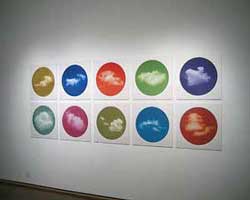Happy Wanderer: Ted Kinkaid at Marty Walker Gallery
By James Michael Starr, D

"LA Sky 803", 2009
The photo-based work of Ted Kincaid may itself be an illustration. For one thing, his medium, perhaps more than any other, proves the disparity between what we see and what we think we see. If Picasso was right, that “art is a lie,” then photography is a whopper, and Kincaid, a Dallas-based artist acclaimed for nuanced, digital manipulation, can stretch the truth like nobody’s business. This exhibition, I Do Not Want The Constellations Any Nearer/L.A. Skies, addresses this looking at things by freezing the glance and showing us how, in another sense, we see more than we think we do. I was happy to see something in Kincaid’s lies, without really knowing how they happened.

Clouds (installation), 2010
For instance, in Constellation’s ten-part grid of cloud portraits, Kincaid offers us a perspective like one we might have if lying on a hilltop, looking straight up into a partly cloudy sky. Not only are we enabled to stare long at these meteorological wisps, which in real time as fleeting and liquid as reflections on water, but we may also realize, while considering their circular, rondo format, that it is the same way the brain outlines our every view. While the rectangular frames of paintings and televisions or movie screens have led us to conclude ours is a letterbox view of the world, it is in fact disc-shaped. More like an IMAX 3D theatre screen, we actually see everything we look at within our own rondo frame.
In another grouping, Trees, comprising nine isolated views arranged in a three-by-three grid, the artist suggests a whole that is less than the sum of its parts. From the normal viewing distance, three to four feet, we contemplate the sculptural form of mostly bare trunks and limbs from a variety of trees. Back up though, and the assemblage appears to plant a single large tree inside the gallery. Kincaid has collaborated with us to make a whole new tree – out of many, one.
In the process, he also demonstrates that our visual assessment of a subject often comes about as the result of another mental machination, the stitching together of a series of more tightly cropped details, which we’ve imaged, one-by-one, on our own. Sure, we can see an entire tree, but in reality our wandering eyes more often take it in as a series of smaller “shots.” A glance here, a glance there, and, in our heads, ta-da, a tree.
Within the intimate space of the gallery, the installation itself surrounds us and creates a grounding sense of environment: the Trees and Clouds of the Constellation series on one side, and on the other (amusing to me because we face west) two prints employing the deceptive color and manipulation of Kincaid’s series, L.A. Skies. This curatorial decision might explain the show’s title, which is itself a line from one stanza of a Walt Whitman poem, “Song of the Open Road”:
The earth—that is sufficient;
I do not want the constellations any nearer;
I know they are very well where they are;
I know they suffice for those who belong to them.
Much has been made about Kincaid’s “kinship with painting” as well as getting into specifics about his digital manipulations. Perhaps it’s necessary. Here in Dallas, we may still need to draw out the last few holdouts reluctant to grant photography its legitimacy as an art form; and some folks don’t like it when your art comes too easily to you.
But excessive exposition can suck the life and the art right out of a thing. Kincaid has found plenty of wonder for his wandering eye to light upon. It’s just a matter of knowing how to look.
